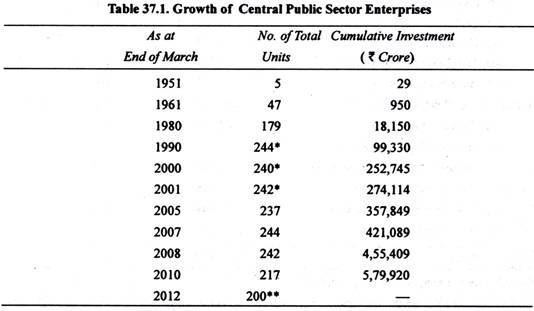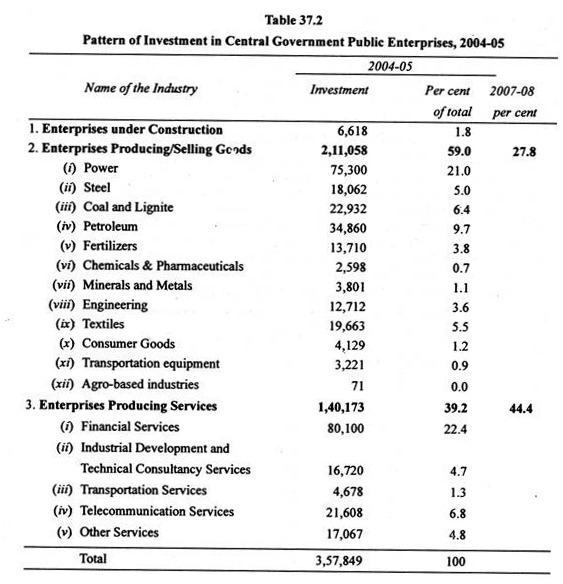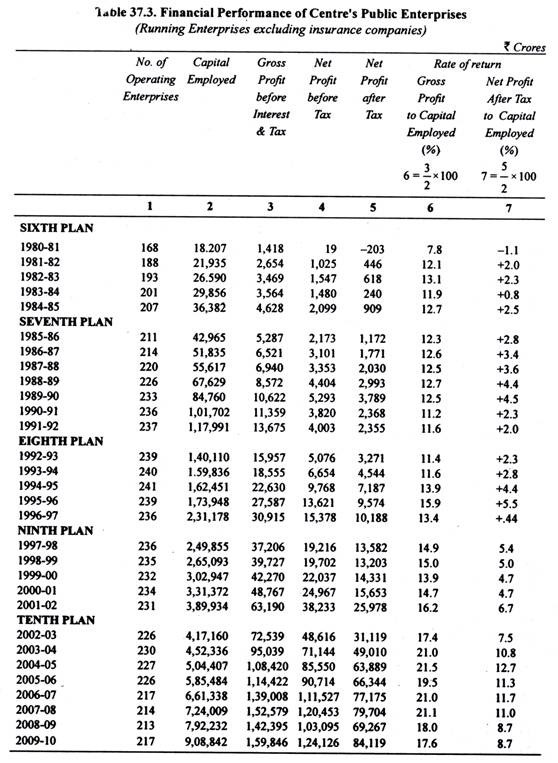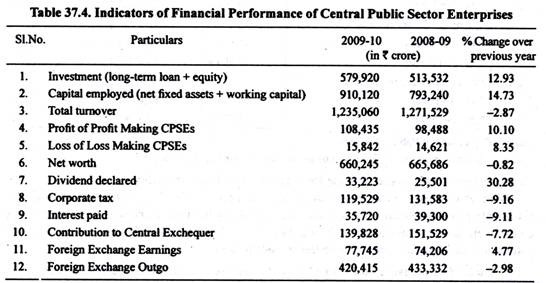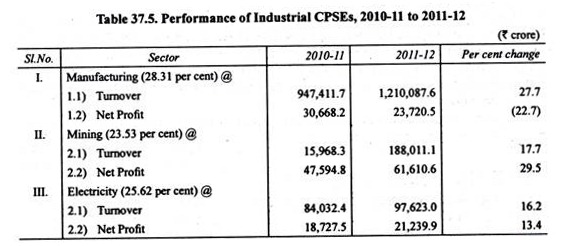Let us make in-depth study of the growth and performance of public sector in India.
Growth of Public Sector:
Since 1956, there has been an impressive growth of the public sector enterprises. Both the Central and State Governments have set up industrial enterprises for production of both goods and services.
The amount of investment in public sector enterprises has been rapidly increasing. The growth of public enterprises started by the Central Government can be observed from Table 37.1.
It will be seen from this table that whereas there were 5 industrial public sector units of Central Government with a capital investment of Rs. 29 crore in 1951, the number went up to 244 in 1990 with investment of Rs. 99,330 crore. At the end of March 2008, the number of Central Government Public Enterprises stood at 242 with a total cumulative investment of Rs. 4,55,409 crore. At the end of March 2010, the total number of public sector units fell to 217 but cumulative investment in them rose to Rs. 5,79,920 crore.
Pattern of Public Sector Investment:
ADVERTISEMENTS:
It would be of great interest to describe the pattern of investment by the Central Government. It will be seen from Table 37.2 that in keeping with role assigned to the public sector by India’s plans in the fields of development of economic infrastructure (power, transport, telecommunications) and basic heavy industries (power, steel, petroleum, coal, fertilizers, etc.), of the total (both equity capital + long-term loans) investment of Rs. 3,57,849 crore, in 2004-05, Rs. 75,300 crore (21%) were invested in the power production, followed by Rs. 34,860 crore (9.7 per cent) in petroleum, Rs. 22,932 crore (6.4 per cent) in coal and lignite, Rs. 13,710 crore (3.8%) in fertilizers, Rs. 18,062 crore (5.0%) in steel, Rs. 21,608 crore (6.0 per cent) in telecommunication services.
At the end of 2007-08, the total cumulative investment in all the CPSEs stood at Rs. 4,55, 409 crore. The largest share in this total investment belonged to the services sector (44.4%) followed by power (i.e., electricity 27.95%), mining sector (8.83%) and agriculture (0.04%).
ADVERTISEMENTS:
The remaining investment (10.55%) of CPSEs was under construction. Thus, a major part of public investment by Central Government has been made in infrastructure such as power, coal, petroleum and basic heavy industries such as steel, fertilizers, engineering. Public investment in financial services (which include commercial banks, nationalized insurance companies) Rs. 80,100 (22.4 per cent of total public sector investment) was made till the year 2004-05. It may however be noted that a great deal of investment in CPSEs is being made through internal resources rather than through investment from outside.
On the other hand, it will be noticed that a relatively low per cent of capital investment by Central Government has been made in textiles and consumer goods. However, it is important to note that a good number of sick industrial units belonging to textiles and consumer goods was taken over by the Central Government from the private sector.
In 2004-05, Rs. 19,663 crores (5.5%) remained invested in textiles. This was done for the purpose of protecting the interests of workers who would have become unemployed if these sick private sector enterprises would have closed down.
Performance of Public Enterprises:
The performance of public enterprises like the private sector enterprises are generally judged on the profitability criterion. Public enterprises are generally criticised on the ground that their performance has been very poor in terms of rate of return or profit made on capital investment.
ADVERTISEMENTS:
In Table 37.3 we have provided the data showing various measures of profitability of Central Public Sector Undertakings. It will be seen from this table that in the year 1991-92 when the process of privatization or disinvestment was started, profitability of Central Public Enterprises was relatively low. Profitability measured in terms of per cent of gross profits to capital employed was 11.6 in 1991-92 and 11.4 in 1992-93. Profitability measured in terms of net profit after tax to capital employed was 2.3 per cent in both 1991-92 and 1992-93.
However, an important point worth noting from Table 37.3 is that beginning from 1994-95, profitability of Central Public Undertakings has greatly improved. Thus, ratio of gross profit to capital employed, which was 11.6 per cent in 1991-92, rose to around 14 per cent in 1994-95 and to 16 per cent in 1995-96.
In more recent years, rate of gross profits to capital employed rose to 16.2 per cent in 2001-02, 17.7 per cent in 2002-03, 21 per cent in 2003-04 and 21.5 per cent in 2004-05. Corresponding ratio of net profit after-tax to capital employed rose to 6.7%, 7.8%, 11.7% and 13.0% in 2001-02, 2002-03, 2003-04 and 2004-05 respectively. However, a very significant fact about the profits of public enterprises is that a major part of them is contributed by the petroleum sector enterprises.
For example, in 2004-05 the net profit after tax of all central public sector enterprises amounted to Rs. 65,429 crores of which about 41 per cent was contributed by petroleum sector enterprises alone. It will be seen from Table 37.3 that rate of gross profit to capital employed was 21.1% in 2007-08, 18% in 2008-09 and 17.6% in 2009-10.
It may be further noted that in order to improve the efficiency and profitability of public undertakings, they have been given autonomy by the Government in their working and decision-making through signing of Memoranda of Understanding (MOUs). In 2000-2001, 107 PSUs signed Memoranda of Understandings. It is expected that with the autonomous functioning the efficiency and profitability of these enterprises will further improve.
Other Efficiency Criteria of Evaluating Public Sector Enterprises:
Public sector enterprises should not be judged on the basis of profitability alone. There are other criteria by which they can be judged.
They are:
(1) Technical efficiency,
(2) Allocative efficiency, and
ADVERTISEMENTS:
(3) Dynamic efficiency.
Technical efficiency implies ratio of output produced by an enterprise to inputs used, which is also called total factor productivity. Allocative efficiency refers to the correction of market failures by the production of certain essential products by public enterprises which private enterprises will not produce on the basis of free working of price mechanism.
In this case production by public enterprises leads to better allocation of resources. Dynamic efficiency relates to introduction of innovations and up-gradation of technology. On these criteria, public enterprises do not fare badly as compared to private enterprises.
In addition to these, public enterprises have made significant contribution to increase in investment or gross domestic capital formation (GDCF) and for achieving broad-based industrial growth. When there was a decline in public investment from mid-sixties to mid-seventies and during the late nineties, there was a slowdown in industrial growth.
ADVERTISEMENTS:
The major highlights of the performance of CPSEs during 2009-10 are given in Table 37.3. It will be seen from this table that net profit after tax of central public sector enterprises stood at Rs. 84,119 crore as compared to Rs. 69,267 crore in 2008-09.
Besides, the gross profit (before interest and tax) to capital employed of these enterprises in 2009-10 was 17.6 per cent as compared to 18 per cent in 2008-09. The year 2009-10 also witnessed severe financial under-recoveries by public sector oil marketing companies as they had to keep the prices low in the domestic market on sales of petroleum products.
It will be seen from Table 37.4 that cumulative investment (paid-up capital plus long term loans) in all the CPSEs stood at Rs. 5,79,920 crore as on 31 March 2010, an increase of 12.93 per cent over 2008-09. The capital employed in all the CPSEs went up by 14.73 per cent during the same period. A great deal of investment in CPSEs is accounted for by internal resources rather than through investment from outside.
ADVERTISEMENTS:
The net profit of the profit-making CPSEs (158) stood at Rs. 1,08,434.68 crore in 2009-10. The net loss of the loss-making enterprises (59), on the other hand, stood at Rs. 15,842 crore during the same period. The year also witnessed severe financial under-recoveries by public sector oil marketing companies (OMCs) as they had to keep prices on sale of petroleum products low in the domestic market. The foreign exchange earnings of the CPSEs amounted to Rs. 77,745 crore during 2009-10 and were clearly overtaken by the foreign exchange outgo of Rs. 4,20,415 crore (Table 37.4).
It will also be seen from Table 37.4 that net worth of Central Public Sector Enterprises (CPSEs) decreased by 0.82 per cent in 2009-10 over 2008-09, dividend declared increased by 30.28 per cent, corporation tax paid declined by 9.16 per cent and contribution to central exchequer decreased by 7.7 per cent.
Besides, CBSEs earned foreign exchange amounting to Rs. 77,745 crore during 2009-10. Thus, the overall performance of Central Public Sector enterprises is not bad keeping into account that many public sector enterprises lay greater emphasis on achieving non-financial social objectives.
The Recent Performance of CPSEs in Terms of Turnover and Net Profit:
The latest complete results are available for the year 2011 -12. CPSEs in the mining sector registered the highest increase in net profit (29.5 per cent) in 2011-12. CPSEs in manufacturing sector recorded a decline of 22.7 per cent in net profit in 2011-12 despite 27.7 per cent increase in their turnover. The electricity sector recorded growth of 16 per cent in turnover and 13.4 per cent in profit (Table 37.5).
